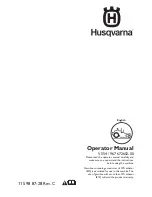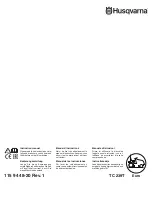
in particular do not play with the ON/OFF
switch.
앬
As a result of the voltage fluctuations this
mower causes as it gets up to speed, other
equipment connected to the same circuit
may suffer faults if the mains supply is not
in perfect condition. In this case suitable
action has to be taken (for example connect
the mower to a different circuit or run the
mower on a circuit with lower impedance).
앬
Disconnect the plug from the power supply:
- whenever you leave the mower.
- if the mower starts to suffer unusual
vibrations (check immediately).
2. Explanation of the warning
signs on the machine
(see Fig. 22)
1= Read the directions for use before
operating the equipment.
2= Keep all other persons away from the
danger zone.
3= Caution: Sharp blades! Pull out the power
plug before carrying out any repair work or
if the power cable is damaged. The blades
will continue to rotate after the motor is
switched off.
4= Caution: Keep the power cable away from
the cutters!
3. Layout and items supplied
(see Figs. 1+2)
1. ON/OFF switch
2. Cable grip
3. Carry handle
4. Grass bag
5. Ejector flap
6. Power cord
7. Top push bar
8. Lower push bar
9. Push bar bracket
10. Fastening screws for push bar
11. Cable clips
12. Fastening screws for push bar bracket
13. Key for changing the blade
14. Frame parts for grass bag
4. Proper usage
Power connection
The lawn mower can be connected to any
socket (with 230 V alternating current).
However, only use a socket with an earth
connection protected by a cable protection
switch for 16 A.
Additionally, a residual current device (RCD)
circuit-breaker with max. 30 mA must be used!
Mower mains lead
Only use a mower mains lead that is in perfect
condition. The mains lead must not exceed a
certain length (max. 50m), since otherwise the
power of the electric motor will fall. The mains
lead must have a cross-section of 3 x 1.5mm
2
.
Mains leads on lawn mowers are particularly
susceptible to insulation damage.
The causes of this include the following:
- Cutting the cable by passing over it with the
mower
- Damage through crushing if the mains lead is
routed under doors or windows
- Cracks caused by ageing of the insulation
sheath
- Kinks caused by incorrect fastening or routing
of the mains lead.
21
GB
Anleitung E-EM 1232_SPK7:_ 11.10.2007 9:13 Uhr Seite 21
Содержание E-EM 1232
Страница 4: ...4 3 4 6 8 5 7 C B B A A Anleitung E EM 1232_SPK7 _ 11 10 2007 9 13 Uhr Seite 4...
Страница 5: ...5 9 10 11 12 13 14 A A Anleitung E EM 1232_SPK7 _ 11 10 2007 9 13 Uhr Seite 5...
Страница 6: ...6 16 15 17 19 18 20 A B A B 2 C A A B 2 C Anleitung E EM 1232_SPK7 _ 11 10 2007 9 13 Uhr Seite 6...
Страница 7: ...7 21 1 2 3 4 22 Anleitung E EM 1232_SPK7 _ 11 10 2007 9 13 Uhr Seite 7...
















































